Technology Product Canvas Template
Create alignment and clear expectations around the technical product roadmap.
About the Technology Product Canvas template
What is a product canvas?
A product canvas is a planning tool designed to help build products that have a great user experience through a focus on feature development. It combines agile methodologies with UX principles to help validate product solutions.
What is a Technology Product Canvas?
To execute your projects, it’s vitally important for engineering and product management to be aligned on objectives and strategies. A Technology Product Canvas is a quick way to facilitate team discussion by getting everyone on the same page. By going through the process of creating a Technology Product Canvas, you can start managing alignment between the teams -- in under an hour.
Use the Technology Product Canvas template to help your teams articulate product roadmap goals, technology roadmap goals, and to discuss how the maps align. This exercise allows you to uncover any gaps in the teams’ processes and ensures everyone is working in sync.
Technology product canvas vs traditional product canvas
While similar, the technology product canvas was specifically designed for technical product development, where a traditional product canvas is designed for any product. The technical product canvas includes features specifically adapted for technical planning.
When do you use the Technology Product Canvas?
It's best for the product owner to introduce the Technology Product Canvas after they've defined the product vision, conducted user story mapping, and developed the initial product release roadmap. At this point, it is clear which features are necessary for the release and teams are prepared for a detailed technical discussion.
How to create a Product Technology Canvas
Step 1: Define metrics for success
How will you know if your plan is working? How does your plan map to overall business goals? Focus on metrics first to ensure the product and engineering teams both understand what they are working toward.
Step 2: Fill in the Product Vision and Product Release sections
Now that you have your metrics, it’s time to align the team on your product vision. How do you currently define your product development priorities? Make a note of a few key products you are looking to ship in the next quarter or year. Fill these in together.
Step 3: Match the Technology Vision with the Product Vision
Ask the technology team to define their vision for how the technology architecture is going to evolve. They can capture this information in the Technology Vision, a big-picture statement that outlines their plans for development.
Step 4: Match the Technology Plans to Product Goals
Define the Technology Plan for each upcoming releases. Ask the technology team to be as specific as they can. Then see how those plans match up with your goals.
Step 5: Identify risks and resources
Finally, discuss potential risks and the resources you will need to complete the project.
What is the benefit of a Technology Product Canvas?
Miscommunication between product development and technology teams is often inevitable, especially in high-growth companies. Everyone is under pressure to deliver quickly and under budget, so the tendency is to act now and communicate later. The Technology Product Canvas allows you to avoid costly errors by aligning both teams.
Get started with this template right now.
Bull's Eye Diagram Template
Works best for:
Diagrams, Project Management, Prioritization
When you’re a growing organization, every decision can feel like it has make-or-break consequences—which can lead to decision paralysis, an inability to prioritize, inefficient meetings, and even low morale. If that sounds like you, put a Bull’s Eye Diagram to work. True to its name, a Bull’s Eye Diagram uses a model of concentric circles to help companies establish priorities, make critical decisions, or discuss how to remove or overcome obstacles.
Timelining
Works best for:
Planning, Timeline
Timelining is a versatile template designed for creating detailed project timelines. It allows you to outline tasks, milestones, and deadlines, helping you manage projects efficiently. Whether for business or personal use, this template ensures you stay organized and on schedule.
RAID Log Template
Works best for:
Agile Methodology, Project Management, Agile Workflows
Use the RAID Log template to better understand potential risks, assumptions, issues, and dependencies relating to an upcoming project. With this information, you can make effective contingency plans and prepare your resources accordingly. You’ll know what could go wrong throughout the project and how to fix the problem.
Automated Security Response on AWS Template
Works best for:
AWS
The Automated Security Response on AWS template is a tool for enhancing AWS security through automation, enabling quick identification and mitigation of threats with minimal manual effort. It integrates with AWS security services for a dynamic response mechanism, ensuring infrastructure security against evolving threats. This template streamlines operational efficiency, offers scalable and customizable security strategies, and accelerates threat response times, making it essential for improving AWS security posture.
The Lightning Product Audit
Works best for:
Product Management, Planning
The Lightning Product Audit template streamlines product evaluation processes with a comprehensive framework. By assessing key areas such as market fit, user experience, and feature performance, this template enables teams to identify strengths, weaknesses, and areas for improvement swiftly. With sections for conducting SWOT analysis, user feedback review, and competitive benchmarking, it facilitates data-driven decision-making and prioritization. This template serves as a catalyst for refining product strategies and driving continuous improvement.
Monthly Budget Template
Works best for:
Project management, Planning
Miro's Monthly Budget Template is more than a budgeting tool; it's a step towards more strategic and efficient financial planning. Start today, and take control of your financial future, achieving your projects and goals.
